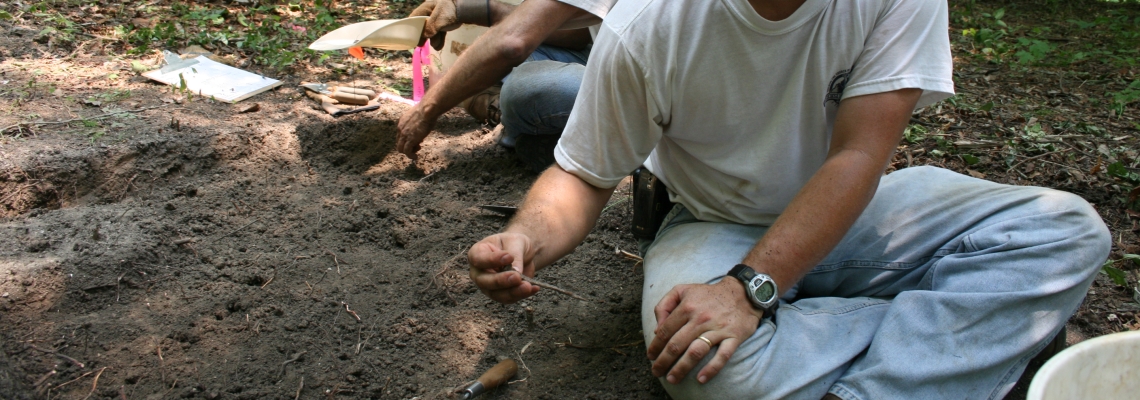
Archaeology
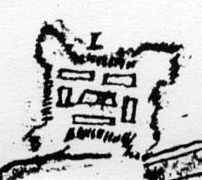
We are fortunate to have many historical documents, maps, and drawings from the European occupations of Fort Tombecbe. Historical documents include correspondence, journals, and official military records. Letters between the fort’s commanders, their superior officers, and government officials inform us about political and military goals and provide information on the diplomatic relationships with regional Indians. Occasionally, this correspondence includes descriptions of particular exciting events that took place at the fort, such as a mutiny or a visit by an important Indian chief. Journals by soldiers stationed at remote posts are not common, due either to low literacy rates or lack of preservation of these documents, but a few such personal accounts do mention the fort and some activities there. In his memoirs, French Lieutenant Jean-François-Benjamin Dumont de Montigny, provides a crude sketch of the fort and mentions a mutiny that occurred at Tombecbe just before he departed with Bienville’s campaign against the Chickasaws. Military records, such as payrolls, inventories, and requisitions, provide glimpses of who was stationed at the posts and the types of goods with which they survived and traded. Each of these records has value, and we continue to study them for more clues about the history of the fort during the French, English, and Spanish occupations.
As informative as they are, however, historical documents do not tell the whole story. They provide a narrow perspective on events by the literate, who were usually middle and upper class, European males, and official records generally are not focused on documenting the circumstances and activities of everyday life that we find so fascinating today. Moreover, the complex relationships between European military personnel, traders, slaves, and Indians are rarely represented in historical documents. Only careful archaeological excavation can help to fill in those missing pieces.
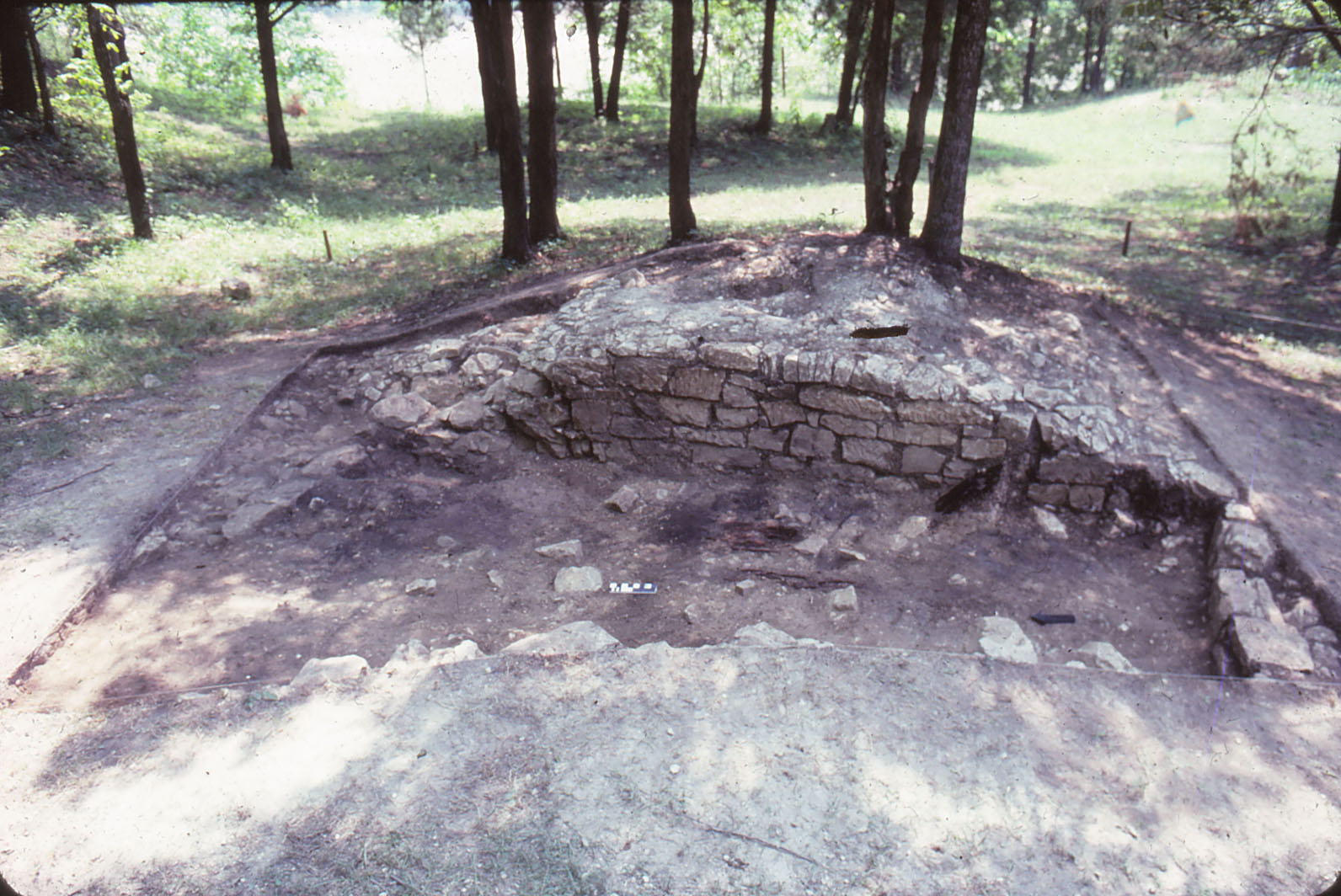
Archaeology was first undertaken in 1980 by students from Livingston University (now UWA), the Alabama Archaeological Society, staff from the Alabama Historical Commission, and other volunteers. Led by James W. Parker, this group focused their efforts on the area of Fort Confederation’s earthworks. They excavated over 100 square-meters, including small rises in the ground that they believed to be the remains of structures and other important features. Excavations revealed the remains of the Spanish prison, the oven, the French prison, and portions of the earthen parapets. The Spanish prison’s foundations were made of cut chalk blocks, though the most intact remaining block was stolen by vandals after the dig. The Spanish oven, which had been located at the end of a long building containing officers’ quarters and the commandant’s kitchen, was discovered partially intact. It was made of several courses of stacked chalk blocks. When adjoining rubble was removed, the excavators found charred boards and white-washed plaster that had made up the kitchen’s walls. Beneath this debris were trenches and post holes associated with the 1736 French prison that had first been located in that spot. Excavations into the earthworks inform us that the southern portion is made of unfinished chalk blocks covered with dirt, while the northern portion is mostly dirt that was capped with a thin layer of chalk rubble.
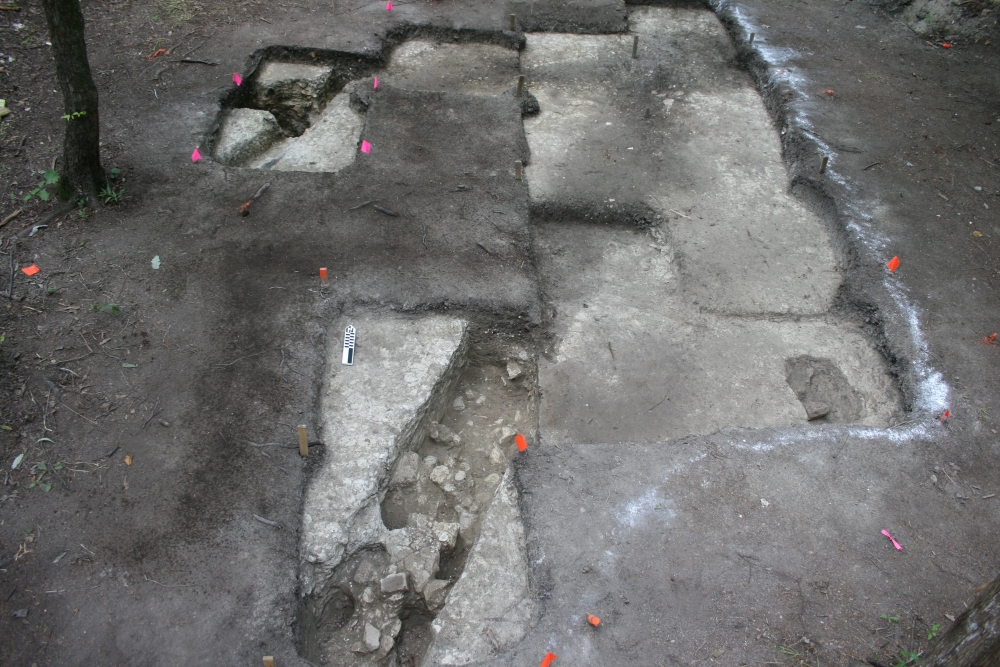
Recent excavations by the Black Belt Museum at UWA were undertaken to search for remains of the French-period Fort Tombecbe that had not been disturbed by the construction of Fort Confederation. When researchers overlaid the 1736 map of Fort Tombecbe with the present-day contours of Fort Confederation’s earthworks, it became clear that the French fort had a slightly larger footprint. This suggested that the undisturbed portions of Tombecbe would be found outside of the latter’s earthworks. To verify this assumption, a team of UWA students opened a few test pits in the suspected location of Fort Tombecbe’s palisade wall. They were delighted to discover that remains of the southwest bastion corner were located exactly as indicated by the maps and were only a few inches below the ground’s surface. The palisade wall is represented by a wide line of soft dark soil that cuts through the surrounding white chalk bedrock. The darker soil resulted from the French cutting a trench through the chalk, in which they set upright posts for the wall. The trench was back-filled and, over time, the posts rotted.*
After confirming the location of the palisade wall, archaeologists could then accurately predict the locations of other features of the fort. Their next target was the bake house and oven located near the southwest bastion.
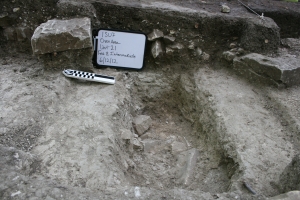
A deep foundation trench and cut chalk blocks are probably associated with a 1750’s reconstruction of the building, which was reportedly in poor shape again just ten years later. Among the rubble found in the foundation trench were blocks of chalk that had been sawn into the shape and size of bricks, offering evidence for the resourcefulness of the builders. A large amount of Choctaw pottery and small pieces of European ceramics were located around the structure. Fragments of clay smoking pipes were common finds, while a shell bead found beneath where the bakery floor would have been located is a unique personal item
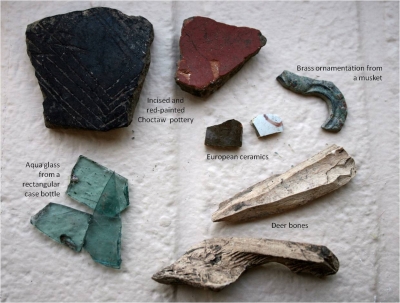
Some of the most common artifacts recovered from the archaeological excavations include a variety of European materials, including coarse and refined earthenware ceramics, bottle glass, iron nails and other architectural hardware, and Choctaw pottery. Items representing the more personal side of life include glass beads, clay smoking pipes, and brass cufflinks. Glass beads were used primarily for trade and are hallmarks of colonial sites in the New World. So far, the collection of artifacts from Fort Tombecbe is not as abundant as similar, contemporaneous fort sites, which would seem to correlate with records of persistent supply problems.
The chalky soil provides ideal conditions for the preservation of bone and accounts for the large amounts of bone recovered from excavations at Tombecbe. Bones from domesticated animals include cows, pigs, chickens, and pigeons, but these were not as common as wild species. Most of the bone is from white-tailed deer, which probably supplied most of the meat for the fort’s inhabitants. In addition, wild turkeys, turtles, and fish were consumed. Like other frontier forts, it seems that Tombecbe’s soldiers lived off the land.
Archaeology will continue to offer insights on the people and activities at Fort Tombecbe, especially as analysis of the excavated artifacts continues. Future digs will be limited in scope and driven by very specific research questions, but students and the public will always be welcome to participate.
Artifacts Gallery
